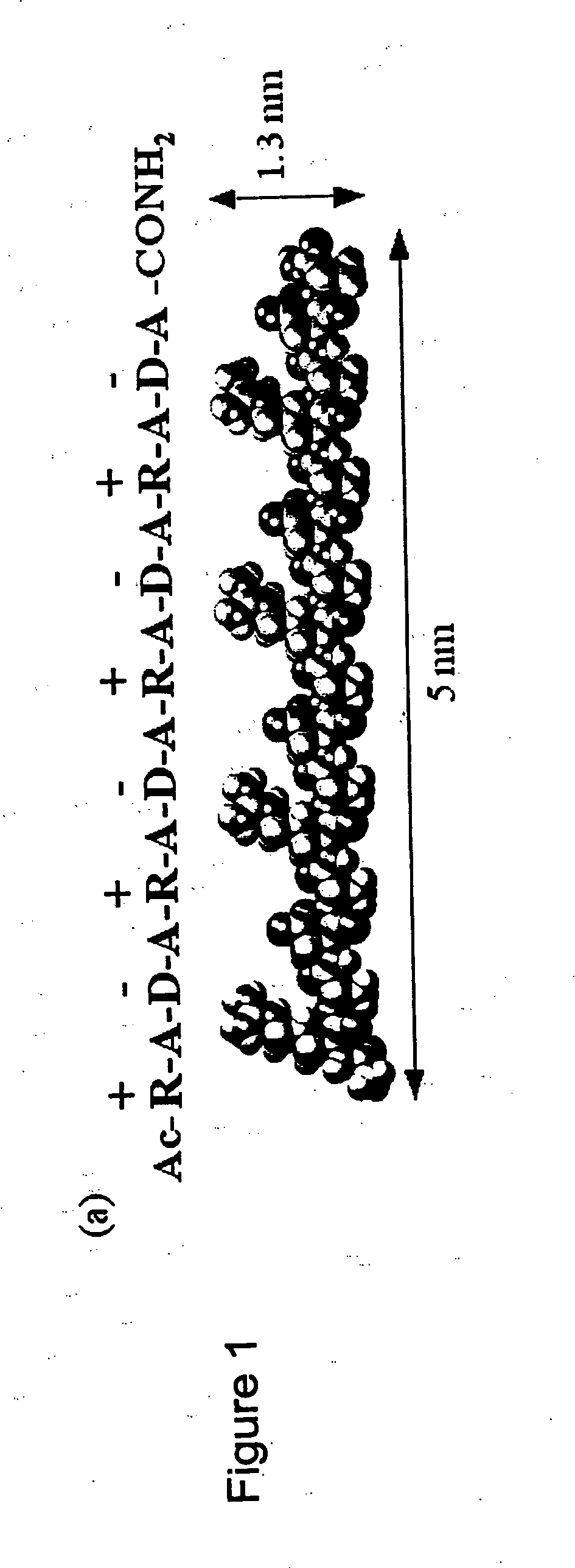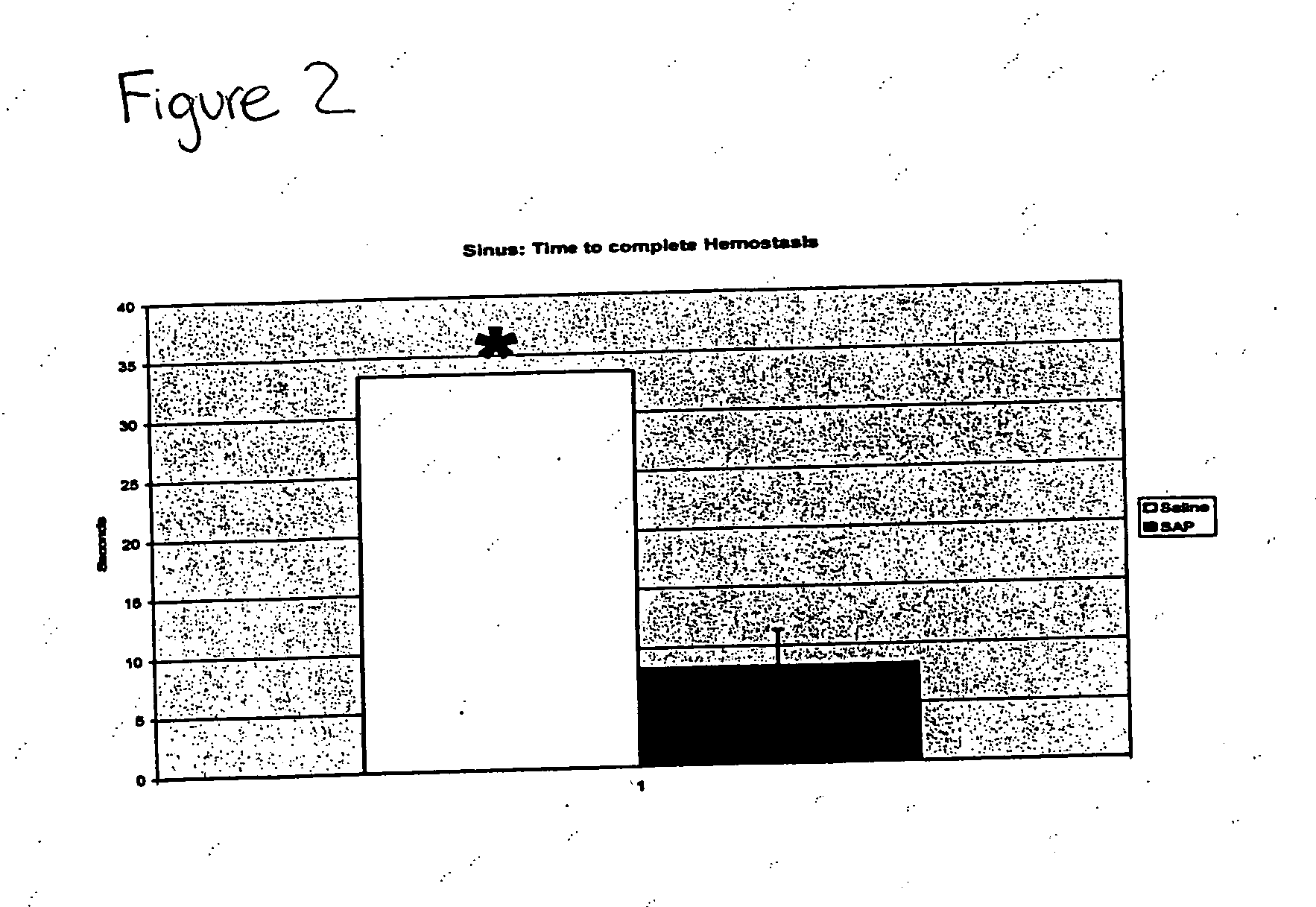Compositions and methods for promoting hemostasis and other physiological activities
a physiological activity and composition technology, applied in the direction of catalyst activation/preparation, drug composition, cardiovascular disorder, etc., can solve the problems of major artery loss, bleeding during surgery, and major morbidity and mortality, so as to promote hemostasis and other physiological activities, the effect of limiting bleeding and rapid
- Summary
- Abstract
- Description
- Claims
- Application Information
AI Technical Summary
Benefits of technology
Problems solved by technology
Method used
Image
Examples
example 1
Self-Assembling Peptide Material Accelerates Hemostasis in the Brain
[0162] Complete transection of a branch of the superior sagittal sinus in the brains of rats and hamsters was performed after removing a portion of the skull overlying the transected tissue. Animals were anesthetized with an i.p. injection of ketamine (80 mg / kg) and xylazine (8 mg / kg). All surgical procedures were conducted under an operating microscope. Twenty-two animals, including 10 adult hamsters and 12 young adult female Spraque-Dawley rats (200-250 g), were treated with either iced saline or 20 μl of a 1% peptide solution at the site of the sinus branch transection. The material was prepared by dissolving RADA16-I (n-RADARADARADARADA-c; SEQ ID NO: 1) peptide in sterile water, and the peptide-containing solution was applied to the injured tissue with a 31 gauge needle attached to a 2 cc syringe.
[0163] The experiment was videotaped with a time stamp and was replayed one frame at a time to evaluate the length ...
example 2
Self-Assembling Peptide Material Accelerates Hemostasis Following Femoral Artery Transection
[0168] The sciatic nerve and the adjacent femoral artery were exposed in adult rats, and the femoral artery was transected. Twelve rats were treated by application of 2011 of a 1% solution of RADA16-I peptide to the site of transection using a glass pipette attached to a syringe body, while controls were treated by applying cold saline to the site of transection. In all treated cases, hemostasis was achieved in less than 10 seconds. The saline control cases continued to bleed until the experiment was terminated at 110 seconds. In these control animals, subsequent replacement of the cold saline with the peptide solution resulted in almost immediate achievement of complete hemostasis.
[0169] A series of pictures was taken in an adult rat in which the femoral artery was transected. In the picture taken first, the sciatic nerve and the femoral artery are exposed. The next picture shows the cutti...
example 3
Self-Assembling Peptide Material Accelerates Hemostasis in Liver
[0173] To further demonstrate the ability of peptide-containing structures to halt bleeding of a vessel having relatively low pressure, the intraperitoneal cavity of an adult rat was opened, the liver was exposed, and the lobus sinister lateralis received a rostral to caudal cut completely transecting a portion of the liver. Profuse bleeding ensued. A 1% peptide solution (RADA16-I) was applied to the cut and in its vicinity using a 27 gauge needle and 4 cc syringe. All bleeding stopped within 10 seconds. A series of pictures was obtained. The first shows exposure of the liver; in the second, the liver is separated, and profuse bleeding is evident; and in the third, the two portions of the liver are allowed to come back together, and the bleeding continues. After treating the site with 1% peptide solution (applied topically and in the cut), all bleeding stopped within 10 seconds. A clear area was observed between the tw...
PUM
| Property | Measurement | Unit |
|---|---|---|
| concentration | aaaaa | aaaaa |
| concentration | aaaaa | aaaaa |
| concentration | aaaaa | aaaaa |
Abstract
Description
Claims
Application Information
 Login to View More
Login to View More - R&D
- Intellectual Property
- Life Sciences
- Materials
- Tech Scout
- Unparalleled Data Quality
- Higher Quality Content
- 60% Fewer Hallucinations
Browse by: Latest US Patents, China's latest patents, Technical Efficacy Thesaurus, Application Domain, Technology Topic, Popular Technical Reports.
© 2025 PatSnap. All rights reserved.Legal|Privacy policy|Modern Slavery Act Transparency Statement|Sitemap|About US| Contact US: help@patsnap.com



